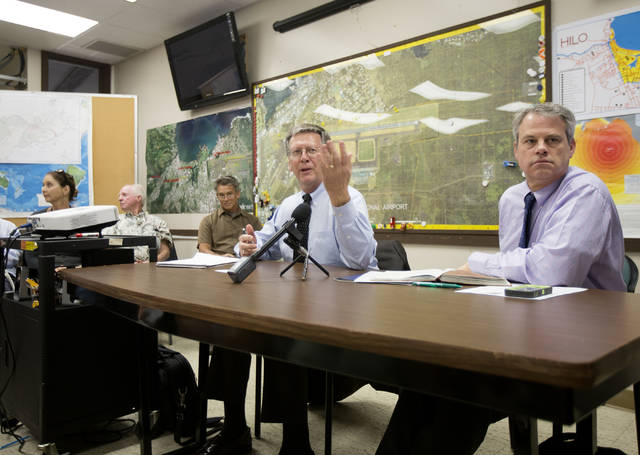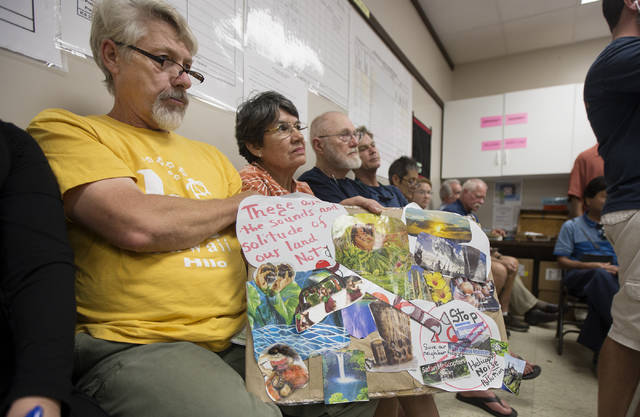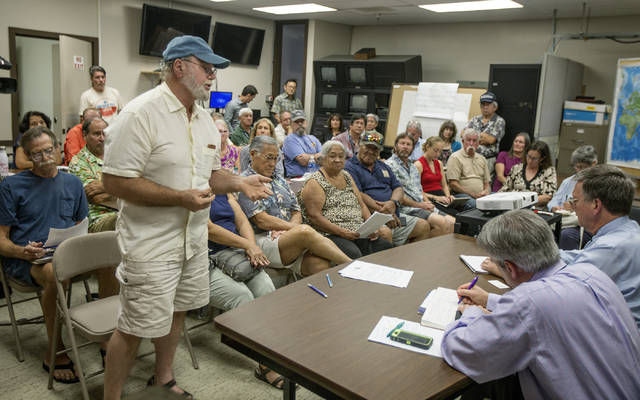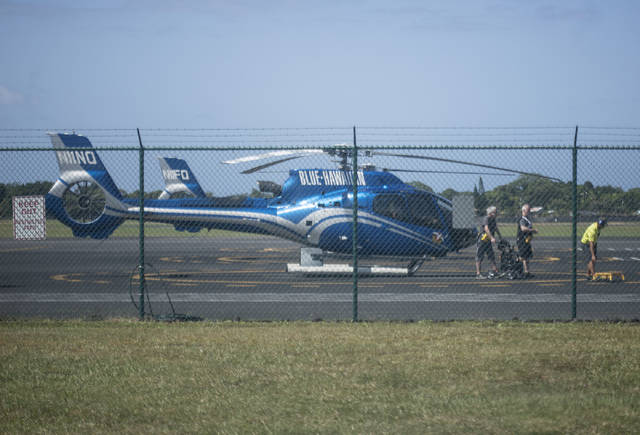‘Messy and complicated’; Residents pack room at Hilo airport to discuss helicopter tour noise pollution with federal officials
Hawaii Island residents received no immediate solutions to the problem of helicopter tour noise pollution during a meeting Thursday afternoon, but were assured that their voices were heard as federal officials once again attempt to address the issue.
ADVERTISING
Representatives from the National Park Service and the Federal Aviation Administration traveled from Washington, D.C., and Los Angeles for the meeting. On Wednesday, a similar event was hosted in Honolulu.
More than 5o people attended the 90-minute meeting at Hilo International Airport, with several others participating via conference call. Conference callers hailed from Maui and, in one case, Arizona, when a member of the Sierra Club spoke.
Representatives from Hawaii’s Congressional delegation — U.S. Sens. Mazie Hirono and Brian Schatz as well as U.S. Rep Tulsi Gabbard — attended, as did Hawaii County Civil Defense Administrator Talmadge Magno.
As an informal discussion and not a public hearing, the meeting was intended as a way for the federal officials to gain better perspective on the situation.
Dennis Roberts, Western-Pacific regional administrator for the FAA, said noise issues arose in all parts of his district, which includes Arizona, California and Nevada.
“I’m really here to listen and learn from all of you,” he said.
The meeting was not well-publicized, with many in attendance saying that if there had been more notice, the small meeting room at the airport would not have been enough to contain the already standing-room-only crowd.
“I think we would have had thousands of people in here,” said Puna County Councilwoman Jen Ruggles. “This is a very big issue for our district.”
Fellow Puna Councilwoman Eileen O’Hara also attended the meeting, and Ka‘u Councilwoman Maile David spoke briefly during the conference call.
All three council members said they are frequently contacted by constituents about helicopter noise. Puna and Ka‘u are the districts most affected by the helicopter flyovers because Hawaii Volcanoes National Park and the Pu‘u O‘o lava flow lie within them.
Several people at the meeting said they regularly recorded more than 100, and in some cases more than 200, helicopter flights over their homes in a single day. Others said flights can begin as early as 6:15 a.m.; that flights take place even on holidays; that they are concerned about pollutants getting into catchment tanks; and that helicopters were flying at dangerously low altitudes.
“We haven’t even talked about potential crashes in residential areas,” said Brent Magstadt of Keaau.
“What is true is that nothing has been done and that complaints seem to be swept under the rug,” said Storm Steiger of the Hawaii Island Coalition Malama Pono, a nonprofit dedicated to ending the helicopter noise problem.
A major contributor to inaction is the uncertainty regarding who people are supposed to contact regarding enforcement.
Neither the NPS nor the FAA actually regulates noise, said Alan Yamamoto, Hirono’s state director. When calls are made to the state Department of Transportation, he said, they are passed on to the FAA and logged in the system, but with no enforcement action taken.
“When people call to complain, they can’t get a resolution,” Yamamoto said.”I think the frustration is they go to the agencies they believe have regulatory authority … and they have to run around in circles.”
Yamamoto was working for Hawaii’s Congressional delegation when the late Rep. Patsy Mink in Washington, D.C., first proposed federal legislation aimed specifically at overflight noise regulation in the state’s national parks.
“This is a very, very important issue for the NPS,” said Ray Sauvajot, NPS associate director of Natural Resource Stewardship and Science. “It has been for a long time, and it’s been a vexing one for a long time. Our commitment is to get to a better place.”
The helicopter noise issue started shortly after Kilauea began erupting in 1983.
After that, “There was more aircraft noise than wilderness noise,” said Dan Taylor of Volcano, who worked at the park for 20 years. “I’ve been through it for a long, long time now … and almost nothing has changed. We’re listening to the same comments, the same arguments.”
Members of the national park’s Kupuna Council who attended the meeting noted the same thing, presenting a letter signed in 2005 when they were discussing the matter with then-U.S. Sen. Daniel Akaka. They also urged representatives to take into account the sacredness of the land itself and said calling Congress was the only way to get any action taken.
Though the comments and arguments are largely the same as they were decades ago, some variables made the matter worse.
“We have greater populations over where the helicopters fly on the islands, so the (problem) is more acute,” Yamamoto said. Puna, for example, is the fastest-growing district in the state.
And the helicopter noise is not limited to the park and its immediate surroundings. Several people from the Wailuku area said helicopters pass over their homes daily on flights to Rainbow Falls.
Resident James Sutherland questioned why that was permitted when the flight path brought helicopters near Hilo’s medical facilities and its veterans home.
”I think we need to address the dangers in flying over densely populated areas of Hilo,” he said.
“We can’t separate the two; they really are intertwined,” Roberts said. “It’s all part of the big picture. You have to fly over somewhere to get to the park.”
“Air tours present a unique challenge for us,” Sauvajot said. “We manage the stuff on the ground; when we go into the air it becomes much more complicated. It brings in a lot of other players, lots of other participants, and we have to walk this line.”
Neither Roberts nor Sauvajot had immediate solutions for the issue but said they will continue to meet with the state DOT and with the Congressional delegation in the future.
“We got the message, there’s no doubt about that,” Roberts said.
In the meantime, Steiger of HICOP said that he opened a case with the state Department of Health and, in response to Roberts’ suggestion that he begin a congressional inquiry, said he did that as well.
Though some representatives from helicopter companies attended the meeting and took notes on residents’ concerns, they did not offer comment. A meeting between the companies, Roberts and Sauvajot took place earlier in the day, where operating procedures and possible recommendations were discussed.
Roberts did not say what the recommendations were, but said he would make comments available in the future. He also handed out business cards to many in attendance so they could continue to touch base.
“This isn’t the (last) time I’m here,” he said. “I will definitely be back.”
“I absolutely can offer my commitments,” Sauvajot said, calling the issue “messy and complicated.” “This is a top priority concern … . Ultimately, my goal is to make sure we have an enforceable way to protect the resources in the park.”
Email Ivy Ashe at iashe@hawaiitribune-herald.com.






